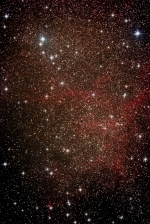Last night was the third night of trying to set up the Hyperstar III and the M26C 10-megapixel one-shot colour CCD. It’s been a bit of a battle and I still haven’t got very good chip flatness and collimation, but it was certainly good enough to do some test shots in Cygnus. Focusing was very good and tracking was excellent – chip flatness and collimation only mediocre – I think it is much harder to get the chip accurately flattened with the smaller pixels of the M26C compared to the larger M25C pixels – this also seems to be a fine tuning problem on the mini-WASP array as well. Not too surprising I suppose, and not too difficult to sort out either – just takes quite a bit of time.
The 10-megapixels of the M26C versus the 6-megapixels of the M25C manifests itself in many ways. My little mini-ATX computer REALLY notices the much bigger file sizes, much longer to download the data files and CCDInspector takes a lot longer to analyse a sub-exposure. But neither of those things matter too much when your images have nearly doubled in resolution. As the Hyperstar III demands a one-shot colour camera, and the full frame sensors are just too big for the C11/Hyperstar III – then I reckon the M26C is just about the most ideal camera you can use with the system.
The accompanying image comprises 5 x 5-minute subs of the NGC6883 open cluster region (with nebulosity) in Cygnus. It lives right next door to NGC6871 another open cluster with nebulosity – and this region will make a really great 2-framer when I finally get the HSIII/M26C fully-tuned up.
I also got an hour’s worth of 15-minute subs on the Sadr region, which I will not show as there are lens flares all over the place (this is a problem with the Hyperstar III unfortunately, you can’t image very bright stars with the HSIII due to the lens flares), and I haven’t bothered correcting the vignetting with a flat (I didn’t bother correcting the vignetting in the NGC6883 image either). However, that said, it gave me the usual very deep result you’d expect with 15-minute HSIII subs (that’s equivalent to 75-minute subs on the mini-WASP array!!) and overall I am very happy with these first First-Light results with the HSIII and the M26C camera 🙂


